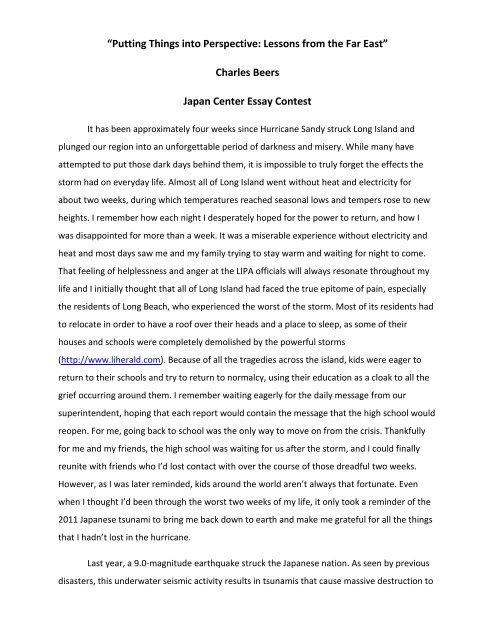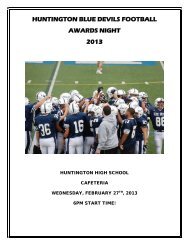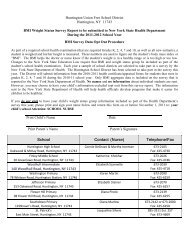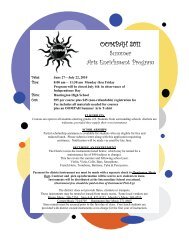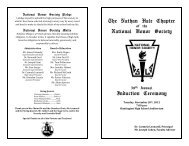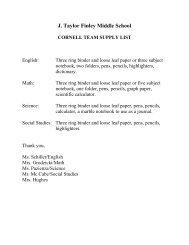Charles Beers' Japan Center Award Winning Essay.
Charles Beers' Japan Center Award Winning Essay.
Charles Beers' Japan Center Award Winning Essay.
You also want an ePaper? Increase the reach of your titles
YUMPU automatically turns print PDFs into web optimized ePapers that Google loves.
“Putting Things into Perspective: Lessons from the Far East”<br />
<strong>Charles</strong> Beers<br />
<strong>Japan</strong> <strong>Center</strong> <strong>Essay</strong> Contest<br />
It has been approximately four weeks since Hurricane Sandy struck Long Island and<br />
plunged our region into an unforgettable period of darkness and misery. While many have<br />
attempted to put those dark days behind them, it is impossible to truly forget the effects the<br />
storm had on everyday life. Almost all of Long Island went without heat and electricity for<br />
about two weeks, during which temperatures reached seasonal lows and tempers rose to new<br />
heights. I remember how each night I desperately hoped for the power to return, and how I<br />
was disappointed for more than a week. It was a miserable experience without electricity and<br />
heat and most days saw me and my family trying to stay warm and waiting for night to come.<br />
That feeling of helplessness and anger at the LIPA officials will always resonate throughout my<br />
life and I initially thought that all of Long Island had faced the true epitome of pain, especially<br />
the residents of Long Beach, who experienced the worst of the storm. Most of its residents had<br />
to relocate in order to have a roof over their heads and a place to sleep, as some of their<br />
houses and schools were completely demolished by the powerful storms<br />
(http://www.liherald.com). Because of all the tragedies across the island, kids were eager to<br />
return to their schools and try to return to normalcy, using their education as a cloak to all the<br />
grief occurring around them. I remember waiting eagerly for the daily message from our<br />
superintendent, hoping that each report would contain the message that the high school would<br />
reopen. For me, going back to school was the only way to move on from the crisis. Thankfully<br />
for me and my friends, the high school was waiting for us after the storm, and I could finally<br />
reunite with friends who I’d lost contact with over the course of those dreadful two weeks.<br />
However, as I was later reminded, kids around the world aren’t always that fortunate. Even<br />
when I thought I’d been through the worst two weeks of my life, it only took a reminder of the<br />
2011 <strong>Japan</strong>ese tsunami to bring me back down to earth and make me grateful for all the things<br />
that I hadn’t lost in the hurricane.<br />
Last year, a 9.0-magnitude earthquake struck the <strong>Japan</strong>ese nation. As seen by previous<br />
disasters, this underwater seismic activity results in tsunamis that cause massive destruction to
High School-CB-Putting Things into Perspective<br />
coastal cities and towns through colossal waves. These waves are virtually unstoppable forces<br />
of nature, capable of demolishing anything in their path. While the <strong>Japan</strong>ese citizens have taken<br />
a multitude of safety precautions to counter these waves, nothing could have prepared them<br />
for what they saw in 2011. Over 10,000 <strong>Japan</strong>ese citizens were killed from the disasters that<br />
ensued and millions lost their homes and even their cities from the damages. However, unlike<br />
Hurricane Sandy in our neck of the woods, children and parents across <strong>Japan</strong> had nowhere to<br />
turn after the tsunami has finally subsided. According to interviews, many <strong>Japan</strong>ese schools,<br />
such as Togura Elementary School, had children in them when the waves appeared on the<br />
horizon, some of them even exceeding the heights that the officials were originally anticipating.<br />
When the tsunami hit, children and teachers had to run for their lives in order to reach an area<br />
high enough to avoid the deadly waves. The aftermath, though, was even more heartwrenching<br />
to imagine. The same township where the Togura Elementary School resided was<br />
completely leveled, some reporters even stating that the town “now barely has any marks of<br />
human existence” (http://www.cnn.com). In short, nothing was saved from destruction, and<br />
the helpless children who suffered through this ordeal had nowhere to go and nothing to come<br />
back to. Trying to imagine these horrific events unfold was difficult for me to do and evoked<br />
newfound levels of grief inside me, as well as an equal amount of guilt. While I was worrying<br />
about when electricity would return to my house, children across the seas were worrying where<br />
they would live and go to school. Reflecting on their catastrophe should serve as a lesson for all<br />
Hurricane Sandy victims. Be grateful for the luxuries you have, such as friends and a school<br />
where you can be safe from harm, and when you feel like you have gone through the worst of<br />
times, always remember the <strong>Japan</strong>ese tsunami survivors, the men and woman who continue to<br />
persevere in spite of having the weight of the world on their shoulders.
High School-CB-Putting Things Into Perspective<br />
Works Cited<br />
Laje, Diego. "Stopped time: <strong>Japan</strong> tsunami hits school." CNN World (2011): n.pag. CNN. Com.<br />
Web. 25 Nov 2012.<br />
.<br />
Rifilato, Anthony. "It Takes More Than a Hurricane." LI Herald.com (2012): 4. Web. 25 Nov<br />
2012. .


